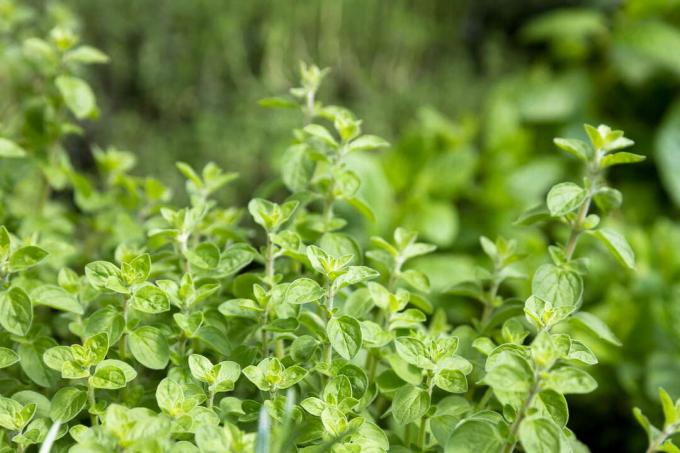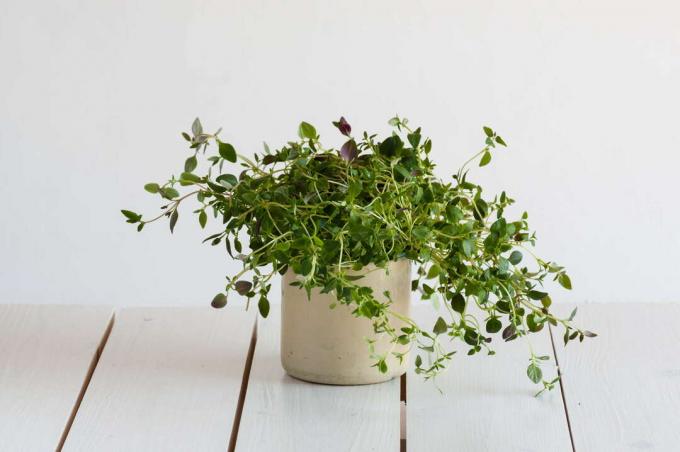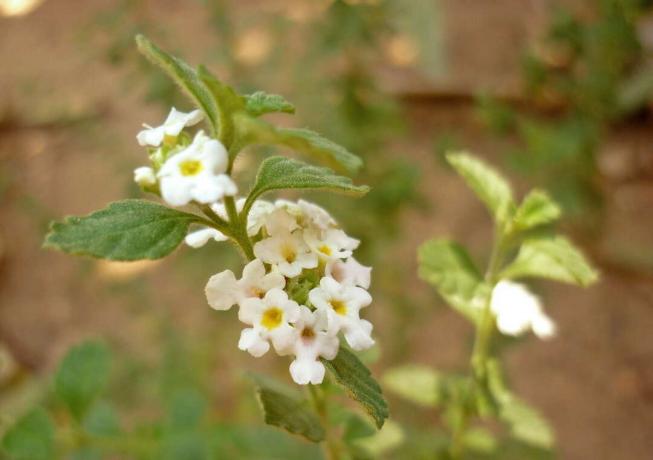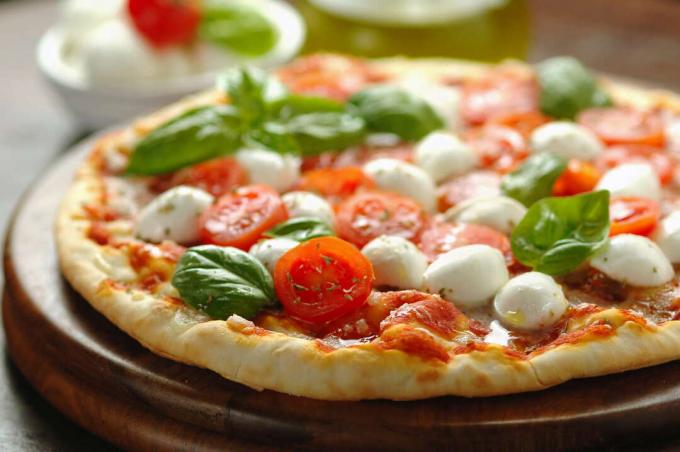The stripped oregano on an oven-fresh pizza completes the Italian classic. We present everything you need to know about the tart and spicy herb.

oregano (Origanum vulgare) belongs to the mint family (Lamiaceae). Many more famous herbs like thyme (Thymus vulgaris) and sage (Salvia officinalis) are thus related to him. It is often referred to as a dost - but this is misleading. Dost is namely the common name of the entire genus Origanum. The oregano is a perennial, herbaceous plant that can reach a height of 20 to 70 cm. The oregano grows more or less upright. It forms a rhizome whose underground rhizomes push shoot buds to the surface of the earth. These filigree buds are the wintering organs of the Mediterranean herb. Its winter hardiness is relatively limited due to its origin in the milder Mediterranean regions. On the other hand, the pizza herb is relatively easy to care for when it comes to watering. And oregano can boast not only with its Mediterranean flavor, but also with its healing powers. We will introduce you to the representative of Mediterranean herbs and show you how they can also grow in your garden.
Synonyms: Dost, Dorst, Wilder Marjoram, Wohlgemut
contents
- Oregano: cultivation in your own garden
- Oregano: characteristics of its subspecies
- Harvest and store oregano
- Oregano: Use of the Mediterranean herb
Oregano: cultivation in your own garden
Location
So that your own cultivation of oregano is crowned with success, you should choose the location in your own garden with care. The perennial herb, which originally comes from the Mediterranean region, prefers a sunny and warm location. In addition, the soil should have permeable properties, for example in the form of a certain proportion of sand, and not be too rich in nutrients. Heavy clay or loam soils can be loosened up by incorporating sand or humus and prepared for the cultivation of oregano. The requirements apply to both growing in beds and growing in pots. Since the oregano forms a pronounced root stock with runners, the container for growing in a pot should not be too small. A special herbal substrate such as our Plantura is used for the bucket Organic herb & sowing soil excellently suited.
You can find out more about cultivation in our article Growing oregano: the Mediterranean classic in your own garden.

Multiplication
There are three ways to propagate oregano. Are you already the proud owner of an oregano plant or you find one in the area such, you can separate fresh, young shoots from an existing plant and use cuttings multiply. The best time to do this is in spring from mid-May. Likewise, the entire plant including the root ball can be divided and separated into several plants. This should be done a few weeks before the propagation of the cuttings. Of course you can also buy oregano plants. The specimens from the vegetable department also have a good chance of survival in their own garden. However, they must slowly be adapted to the external conditions in the garden, because in the In the greenhouses of the herb nurseries, they are protected from direct sunlight and cool Night temperatures.

However, oregano seeds are also commercially available. It can take 20 to 25 days for the first seedlings to appear at an average of 15 ° C. In the open air can be started from the end of April, with the pre-cultivation on the window sill from mid-February. Since oregano is one of the light germs, it is best not to cover the seeds with soil to protect them from drying out. This can be remedied by placing a pane of glass over it. As long as it doesn't get too hot under the glass, it can be left over the sowing disc until the first cotyledons appear.
You can find even more tips and tricks at Oregano: Propagate successfully.
Watering and fertilizing
The oregano's evolutionary adaptation to the dry Mediterranean climate has not passed by either. He can get by with very little water and does not resent longer periods of hardship. Waterlogging should even be avoided - due to the high risk of infection with root fungi, this can even lead to oregano's death. While the bed is rarely watered during extreme and prolonged periods of drought an oregano in the pot can, depending on the size of the container, be given daily water if it is very warm and sunny require.
For a sufficient supply of nutrients, it is sufficient to use a primarily organic long-term fertilizer such as ours in spring Plantura organic universal fertilizer work into the soil. When cultivating in pots, an organic liquid fertilizer such as our Plantura can be added to the water every four to six weeks Organic indoor & green plant fertilizer be used. However, this should not be done more often, otherwise the shoots will be long and unstable and the aroma intensity will be lost.
care
If the oregano shoots become too long and leafless over the years, a more radical pruning in early spring before new shoots can be recommended. During the cut, only about 10 cm of shoot length are left standing above the surface of the earth. This also promotes the branching of the plant.
Depending on the type or variety, oregano is hardy. However, the hardest boiled specimens only defy temperatures down to around -15 ° C. Additional winter protection for the plants in the bed in brushwood or mulch is therefore advisable. Oregano pots can simply be placed in the warm for the cold season.

Would you like to find out more about the right care? Then take a look at our article Care for oregano: overwinter, cut and transplant.
Oregano: characteristics of its subspecies
The genus Origanum, to which the described mint family belongs, also contains similar relatives of the popular pizza herb. So it is again and again with the annual and much milder marjoram (Origanum majorana) mistaken. Origanum vulgare It is not without reason that it has established itself as a spice for global cultivation: Almost without exception, it has clear advantages over its close relatives in terms of frost resistance.

Furthermore, oregano (Origanum vulgare) divided into six subspecies depending on the specific geographical occurrence. The best known and at the same time most popular subspecies is the Greek oregano (Origanum vulgare subsp. shepherdess). It stands out from the mostly pink to purple blooming other oregano representatives with a white bloom. In addition, most successful despite the cold winters and is therefore particularly suitable for growing in beds.
Harvest and store oregano
There are two ways of harvesting oregano throughout the summer. If the individual leaves are plucked in very small work, this promotes the abundant and rapid branching of the plant. But even if entire shoots are cut 10 to 15 cm above the ground, the fast-growing plant sprouts quickly. A more radical crop pruning is possible at any time in the frost-free phase. However, if done too late, it can potentially taste the ornamental oregano blossom. The best time to harvest is just before flowering. Then the content of the aromatic essential oils is highest and the taste and smell are therefore the most intense. Furthermore, care should be taken to harvest in the morning hours and not when it is raining in order to intensify the aroma.

Of course, oregano can be used fresh from the harvest - but it doesn't have to. The following options exist to extend the shelf life of oregano without serious loss of flavor:
- dry: The harvested shoots are hung upside down and can be air-dried without any loss of aroma. After the drying process has been completed, the leaves are peeled off the stems and stored under the exclusion of air. This means that the spice can be used very well for more than a year.
- Freeze: The freshly harvested oregano leaves can be frozen and removed as required.
- Insertion: Whole shoots or individual leaves can also be soaked in olive oil. The oil absorbs the essential oils of oregano and is ideal for cooking, marinating or preparing a salad dressing. The plant parts should be completely enclosed by the oil to counteract the formation of mold through contact with air.
You can find even more interesting information at Oregano: harvest and store properly.
Oregano: Use of the Mediterranean herb
Oregano is ideal for cooking and is probably known to everyone from the preparation of classic dishes of Italian cuisine. Sauces, salad dressings and marinades can be perfectly refined with the tangy, spicy herb. It can create a Mediterranean mood both fresh and dried. It is suitable for meat dishes as well as for the preparation of ice cream specialties. An all-rounder, however, which, like no other, masters the right garnishing of hearty dough specialties. No pizza should be without stripped oregano and other Italian classics such as the salty Schiacciata or Ciabatta with tomato-mozzarella know how to refine oregano skillfully.

But the healing power should not be forgotten with all the skill in the kitchen. Because of its ingredients, oregano has some positive effects on the human organism. In the Middle Ages it was already administered to induce childbirth and, as a smoking plant, was supposed to keep evil away. Today we know that it has a relaxing effect on stomach and intestinal problems when taken as a tea. It can also help with bacterial respiratory infections. When processed into oregano oil, the herb can be anti-inflammatory and generally helpful against blemished skin.
Oregano - the Mediterranean pizza herb - should not only be given a place in the herb garden by lovers of Italian cuisine.
